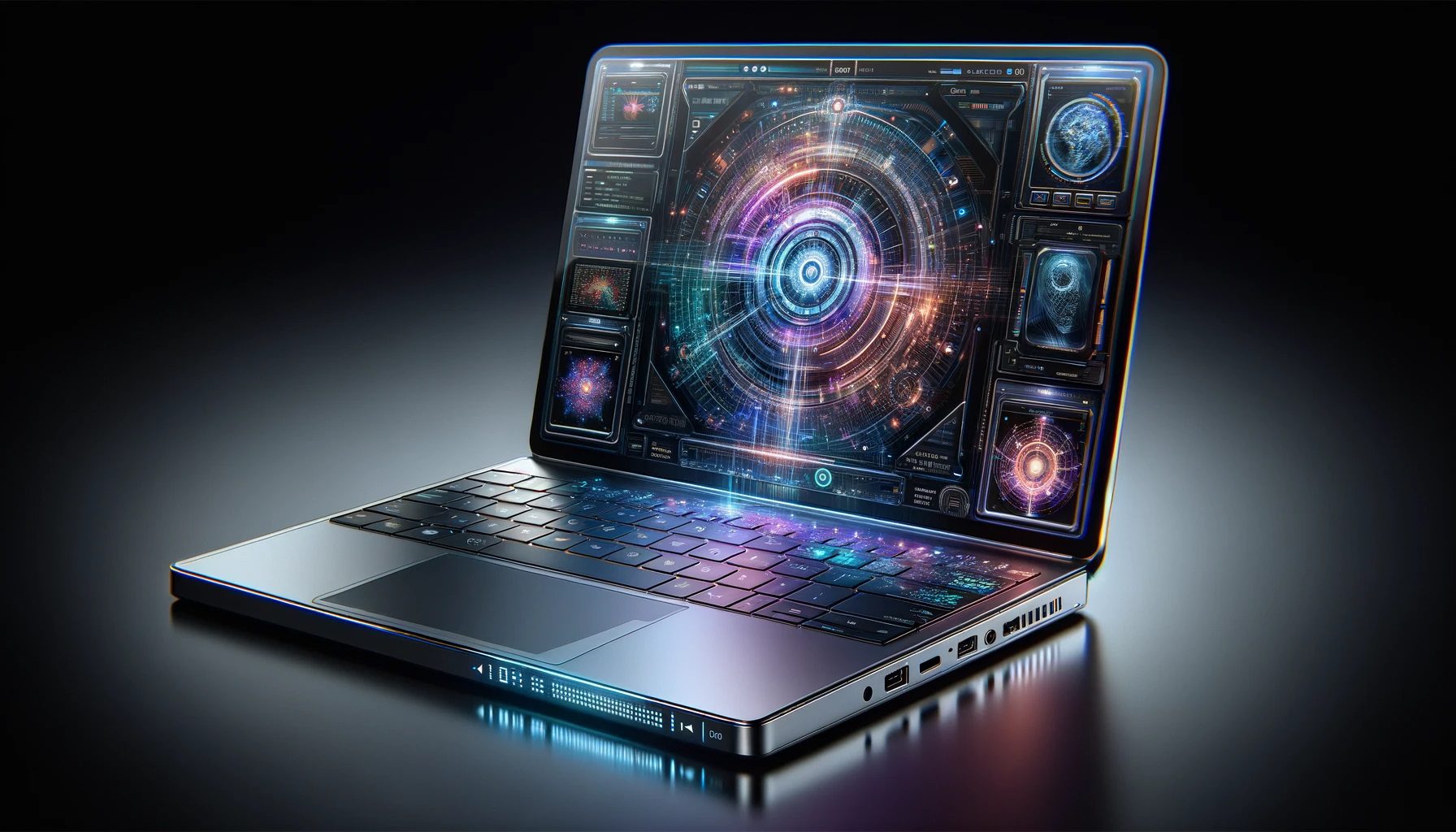What is (not) an AI PC and should you even worry about it?
- January 9, 2024
- 0
AMD and Intel agree on one thing: the classic computer will give way to the AI PC in 2024. New AI chips should ensure this. A thorough marketing
AMD and Intel agree on one thing: the classic computer will give way to the AI PC in 2024. New AI chips should ensure this. A thorough marketing


AMD and Intel agree on one thing: the classic computer will give way to the AI PC in 2024. New AI chips should ensure this. A thorough marketing campaign based on the unmistakable AI hype should help spread the hot air.
For Intel and AMD it is a fait accompli: the AI PC exists. Both chip designers develop the CPUs for the devices and manufacturers like Dell and Lenovo like to claim that they offer the AI PCs for sale. Logic: one old-fashioned You probably have a PC, but one is lying around AI–pcs in your closet?
Since the corona pandemic, PC sales have stagnated again. It’s simply a fact that computers today last much longer than they used to. The only reason a reasonably decently equipped 2017 system can’t run Windows 11 is the artificially restrictive list of system requirements that Microsoft has put together in the name of security. When it comes to horsepower, you can still get a long way in office work even with an older system.
This is difficult for AMD, Intel, Lenovo, Dell, HP and the rest of the club. There is no longer such a practical need to upgrade computers, and this applies to both individuals and businesses. This is a problem, and the AI PC is a possible solution.
Amid the AI hype, chip and laptop manufacturers are happy to tell us that your PC is now too AI must be. In times of ChatGPT there is no other way, right? It almost sounds plausible. In any case, the chip designers are doing their best to flesh out the concept of the AI PC. Both AMD and Intel integrate an AI accelerator (or NPU) into their processor that can adjust the AI workload.
This AI accelerator is receiving a lot of attention when the latest processors are introduced. AMD is dedicating almost its entire announcement to it, which is necessary since the 2024 CPUs are otherwise virtually identical to the 2023 ones. Intel is going one step further and renaming its entire processor line-up to celebrate its focus on AI. Stop saying Core i, say Core Ultra, with AI on board. The entire concept of the AI PC is tied to the supposedly groundbreaking nature of these new chips. Unfortunately, there are three big problems:
We will briefly analyze these three statements, starting with the importance of the NPUs themselves. These are designed to specifically accelerate AI workloads. Acceleration means that workloads are not carried out by the CPU cores themselves, but by an optimized part of the chip that processes AI work much faster and therefore much more efficiently. In addition, the CPU remains free for other, more suitable tasks. This is undoubtedly useful, but not as groundbreaking as the chipmakers claim.
After all, a modern CPU contains numerous accelerators. First of all, every laptop chip has a GPU on board that accelerates graphics workloads and can actually serve as a type of NPU as well. That is not all. Let’s take the Intel Core i7-1355U as an example. This chip predates the AI hype and powers boring old non-AI PCs. However, we find a GNA on board (Gaussian and neural accelerator). This is also a type of NPU, although it focuses primarily on audio. However, the previous generation of laptops were not audio AI PCs.
The chip also contains a special component that accelerates multimedia by processing codecs such as HVEC in hardware. With this multimedia accelerator, your laptop will play 4K videos as if they were nothing, whereas on an old computer the CPU needs to run at full speed. High-resolution multimedia content is ubiquitous, but neither Intel nor AMD nor the laptop manufacturers themselves have seen fit to usher in the era of the HVEC PC.
The processor in our example also accelerates AES and especially AES-NI (New instructions). The accelerator ensures that data can be encrypted (or read) quickly and securely. Yet the marketing departments of the world have never talked about the crypto PC.
This brings us to the second point: AI acceleration is much less relevant today than multimedia acceleration and encryption. When you watch a video on YouTube on your professional laptop, use both (Bitlocker encryption protects your data). Codec engines Make sure the video plays smoothly. If the term crypto-multimedia PC had been invented back then, it wouldn’t have been so stupid. The accelerated functionality is generally relevant. Both on-chip integrations solved current problems.
The new NPUs in the so-called AI PCs do not do this. There are hardly any local AI workloads that need to be accelerated, and a normal user will not encounter the limitations of a classic CPU in this context. AMD and Intel know this well enough. When introducing its latest processors, AMD touted up to a hundred features that leverage its NPU. All hundred features belong to specific (mainly graphics) applications and AMD was generous in counting them. For example, 23 of the hundred functions are buttons in Adobe Photoshop, including all variations thereof Neural filter. Nineteen additional features are included in Black Magic DaVinci Resolve.
Intel says it is doing better and has found 300 uses for its NPU. Again, these are very specific functions that belong to very specific software. This is partly because developers have to optimize their software for the new NPUs. The codec engines and AES acceleration, on the other hand, accelerate the already widespread functionality. The functionality created the need for acceleration, while with the NPU we see a reverse movement.
In fact, the NPU is now a problem-free solution.
In fact, the NPU is now a hassle-free solution: there are no masses of local AI workloads overloading the classic CPU cores. Intel and AMD have also recognized this. Along with its AI chips, AMD has launched the Pervasive AI Developers Contest: a competition designed to encourage developers to effectively write something that makes sense of the NPU. Intel has also started such a program. A multimedia creation competition was (obviously) never necessary to find a use for multimedia acceleration on chips, nor was it necessary for encryption.
The impact of AI today is undeniable, which is why chip and laptop manufacturers are trying to ride on the hype. Unfortunately, the hype is happening almost exclusively in the cloud. You don’t need an AI PC to enjoy ChatGPT: as long as your computer has a browser and internet access, you can get started with the world’s most advanced generative AI model.
Such beautiful models are also far too large to run locally in the near future, even for inference. Smaller functions (like the hundreds mentioned by AMD and Intel) can be accelerated, but what the general public understands as AI takes place on powerful servers in data centers.
Over time, more and more specialized models will appear with useful features that can be run locally. These will undoubtedly trickle down to the general public. When local AI models are ubiquitous, AI acceleration becomes relevant. Today that is no longer the case.
The most important AI integration office workers have to deal with today (besides ChatGPT) is probably Microsoft Copilot. The Copilot also works via the cloud, but can be accessed on the AI PCs using a key on the keyboard. This AI capability has nothing to do with Intel and AMD and is not very welcome in our opinion. Finally, Copilot is not available everywhere and is not free either. In other words, you get an intrusive key that acts more like a billboard than a keyboard shortcut. The AI PC brings a kind of Samsung Bixby button to the Windows ecosystem.
The conclusion is clear: the AI PC does not exist and does not have to exist. The NPUs onboard the latest chips and laptops are the least relevant addition to a long list of accelerators. Things are tailored to workloads that hardly exist today. The AI hype does exist, but it is currently taking place in the cloud.
If that changes, a compatible PC will likely be relevant. Even then, the AI PC will not represent a special device category. By integrating functionality into hardware, computers have evolved with market demands for decades. Encryption and multimedia are just two examples. Intel can put Ultra behind its Core processors and the entire laptop world can scream AI PC all it wants, but that doesn’t change the fact that the term is a hollow concept. Processor and laptop manufacturers want to benefit from the hype that is primarily taking place in the cloud. The AI PC doesn’t exist, don’t fall for it.
Source: IT Daily
As an experienced journalist and author, Mary has been reporting on the latest news and trends for over 5 years. With a passion for uncovering the stories behind the headlines, Mary has earned a reputation as a trusted voice in the world of journalism. Her writing style is insightful, engaging and thought-provoking, as she takes a deep dive into the most pressing issues of our time.